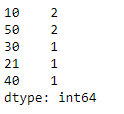Python | Pandas Index.value_counts ()
Python - отличный язык для анализа данных, в первую очередь из-за фантастической экосистемы пакетов Python, ориентированных на данные. Pandas - один из таких пакетов, который значительно упрощает импорт и анализ данных.
Pandas Index.value_counts() function returns object containing counts of unique values. The resulting object will be in descending order so that the first element is the most frequently-occurring element. Excludes NA values by default.
Syntax: Index.value_counts(normalize=False, sort=True, ascending=False, bins=None, dropna=True)
Parameters :
normalize : If True then the object returned will contain the relative frequencies of the unique values.
sort : Sort by values
ascending : Sort in ascending order
bins : Rather than count values, group them into half-open bins, a convenience for pd.cut, only works with numeric data
dropna : Don’t include counts of NaN.Returns : counts : Series
Example #1: Use Index.value_counts() function to count the number of unique values in the given Index.
# importing pandas as pdimport pandas as pd # Creating the indexidx = pd.Index(["Harry", "Mike", "Arther", "Nick", "Harry", "Arther"], name ="Student") # Print the Indexprint(idx) |
Выход :
Let’s find the count of all unique values in the index.
# find the count of unique values in the indexidx.value_counts() |
Output :
The function has returned the count of all unique values in the given index. Notice the object returned by the function contains the occurrence of the values in descending order.
Example #2: Use Index.value_counts() function to find the count of all unique values in the given index.
# importing pandas as pdimport pandas as pd # Creating the indexidx = pd.Index([21, 10, 30, 40, 50, 10, 50]) # Print the Indexprint(idx) |
Выход :
Let’s count the occurrence of all the unique values in the Index.
# for finding the count of all # unique values in the index.idx.value_counts() |
Выход :
Функция вернула количество всех уникальных значений в индексе.
Внимание компьютерщик! Укрепите свои основы с помощью базового курса программирования Python и изучите основы.
Для начала подготовьтесь к собеседованию. Расширьте свои концепции структур данных с помощью курса Python DS. А чтобы начать свое путешествие по машинному обучению, присоединяйтесь к курсу Машинное обучение - базовый уровень.